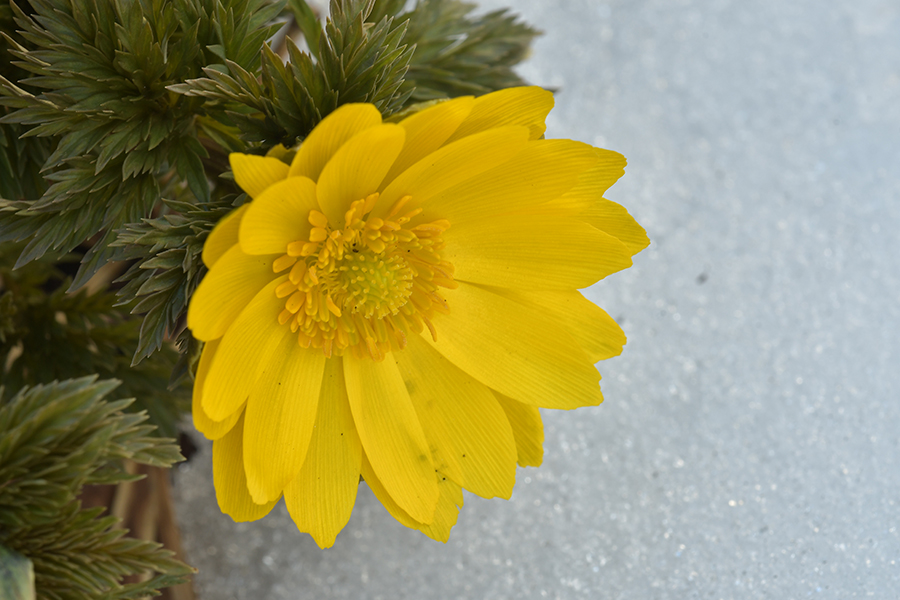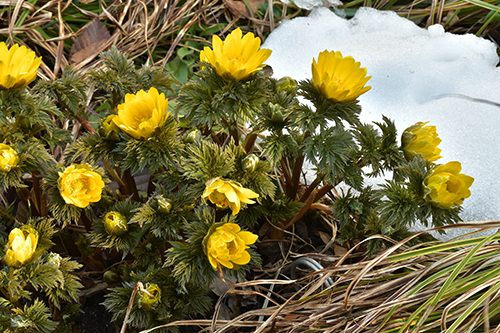
Try as we must, there will always be more plants than a dedicated gardener can possibly learn in a lifetime. Trust me, I am trying! Of course, when you consider the diversity of environments found worldwide and the diversity of plants that have resulted, it is certainly understandable! The challenge is further complicated by spring ephemerals whose lifecycle dictates a 9-month period of dormancy following flowering and seed set. Garden Centers are hesitant to offer such plants, since they will appear as an unappealing pot of lifeless soil throughout the summer and fall. Many interesting spring ephemerals fall into obscurity as a result, not the least of which is the late winter blooming Adonis amurensis, or Pheasant Eye. Pheasant Eye is known for its beautiful golden-yellow flowers that appear before winter's snow has vanished, yet for many gardeners this snow defying ephemeral remains undiscovered.
Adonis is a member of the Buttercup Family, or Ranunculaceae with 20–30 species found throughout Europe, North Africa and Asia. The genus was originally named in 1753 by Carl Linnaeus (1707–1778). The species he studied that proved inspirational for the genus name was Adonis annua. This species is noted for its blood red flowers and reminded Linnaeus of the mythical figure Adonis. As the story is written in Greek mythology, Adonis was the handsome and mortal lover of the goddess Aphrodite. Despite his prowess as a mighty hunter, he was fatally gored by a wild borer. Aphrodite quickly appeared at his side to provide comfort, but was unable to prevent the inevitable. It was the resemblance of his spilt blood to the red color of the flower that inspired the plant's name. Interestingly, while dying the story relays how his blood mixed with Aphrodite's tears and as this mixture hit the ground, it yielded flowers of Anemone! It is fascinating to understand how some flowers 'evolved'! The common name of Pheasant Eye was also inspired by the red flowers and how they loosely resemble the red eyes of a Pheasant.
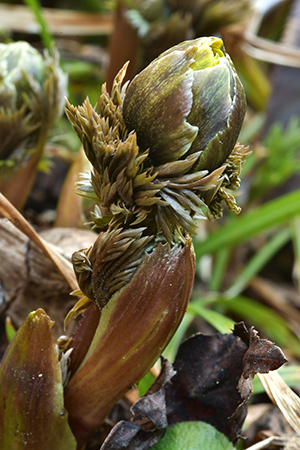
Bearing yellow rather than red flowers, Adonis amurensis is native to China and Eastern Russia, as well as Korea and Northern Japan. The Amur River separates Eastern Russia from China and marks the region where the species was initially found. Obviously, the Amur River valley also influenced the species name. It is believed the plant was first discovered by the Russian botanist Carl Johann Maximovich (1827–1891) in the Bureya Mountains along the Amur River. Maximovich was a prodigious plant collector, discovering over 2,300 new species in his lifetime. Unfortunately, in this instance he mistakenly thought it to be a selection of the very similar appearing Adonis apennina, which is also found in this region. Luckily, Maximovich was not alone in collecting plants in this frigid area. The species was also found, and in part properly named by the German naturalist Gustav Ferdinand Richard Johannes von Radde (1831–1903). From 1855–1859 Radde participated in an extended expedition of the Amur region, led by the Russian astronomer and explorer Peter Carl Ludwig Schwarz (1822–1894). The focus was to study previously unmapped areas of the region, including documentation of the flora and fauna. Radde, in cooperation with the German botanist and horticulturist Eduard August von Regel (1815–1892) described and published Adonis amurensis in 1861. Regel served as the Director of the Russian Imperial Botanic Garden and although he did not travel, he named over 3,000 plants sent to the Botanic Garden by intrepid plant collectors.
Considering its frigid northern and mountainous range, it comes as no surprise that Adonis amurensis is not bashful about initiating growth and flowers while snow still covers the ground (Picture 1). How this plant initiates growth while temperatures remain subfreezing has garnered the focus of numerous studies. The secret to its cold tolerance appears to be from small sugar compounds called osmolytes. These osmolytes act as a natural antifreeze, preserving the viability of cells during freezing temperatures and allowing the plants to thrive without damage.
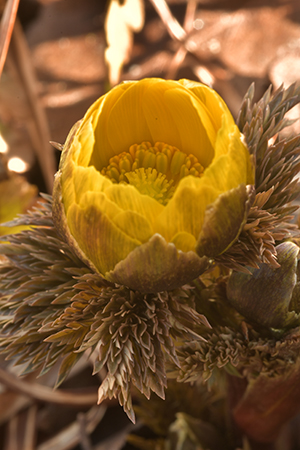
As an interesting anecdote, studies of this species are being used to understand how food crops can be grown in colder or more stressful environments as a result of climate change. Additional protection for the flowers and foliage comes from a powerful antioxidant carotenoid named astaxanthin. This compound imbues the protective bronzy color to the new foliage and the linear markings of the petals and calyx. The carotenoid serves to protect the newly emerging tissues from harsh UV light, including both direct and reflected rays from the surrounding snow.
Science aside, the plant's ability to endure cold temperatures and display bold, golden-yellow flowers certainly makes it a great ornamental for the March Garden. While first emerging from the ground, often as early as January in NJ, the dense tufts of highly dissected foliage are a dark reddish brown, a result of the protective carotenoids. The foliage partially surrounds and shields the flower buds, as seen in Picture 2. Helping to safeguard the flowers further, the protective outer sepals that cover the flower bud are also streaked with broad dark bronze bands, running the length of the individual sepals. The outer surface of the petals is also marked with similar, albeit thinner dark bronze bands (Pictures 3 and 4). As the flowers start to open, the deep color of the foliage provides an attractive backdrop to the bright, golden-yellow flowers. Sadly, the contrast is fairly short lived; with the elongation of the bronzy red stems, the foliage transitions to deep green and ultimately light green. It was originally thought these bronzy stems were long petioles or floral stems, which were divided near the flower to support the foliage appearing beneath the flower. It was the French botanist Adrien René Franchet (1834–1900) whose studies during the late 1800's revealed this petiole was actually a stem bearing several leaves and topped by a single flower with a very short petiole!

As the flowers open, the petals quickly grow longer than the 8 or 9 basal sepals, ultimately hiding them from view. When the flowers are fully open, each flower is a showy 1½–2" in diameter as seen in Picture 5. Like many early blooming plants, the flowers close during cold or inclement weather and are pollinated by bees, flies and beetles. Unusual for a member of the Buttercup Family, there are no nectaries and the reward for the visiting pollinators is the nutrient rich pollen. Based upon the individual plant, the number of petals vary from fewer than 20 to over 30, with each petal narrowly oblong in shape. The petals surround a pronounced ring of well over 100 stamens, which are tipped by ¼–⅜" long anthers. The anthers are oblong and flattened. At the center of the flower the seed-bearing carpels are collected into a globe shaped structure with the styles curiously curved outwards towards the anthers (Pictures 5 and 7).
The flowers continue to open for over a month, following which small, light green and globose seed heads develop. The numerous seed heads are held above the foliage (Picture 6) and the seeds are distributed by ants. Although the plants are self-fertile, I have not noticed any seedlings over the years from the lone plant and the attractive light green and dissected foliage remains through early June before it quietly goes dormant.
The individual plants slowly spread by fleshy stems located just below the surface called rhizomes. In the wild, the plants are found on open stony and grassy slopes or beneath the scrubby growth of weather-beaten shrubs. In the garden, it grows well in morning sun or in cooler locations featuring filtered shade. This only makes sense considering the winter temperatures experienced in the Amur River valley average -20°F with highs around 80°F come summer. Ideally, soils should be well-drained yet rich in organic matter with a shredded leaf or fine gravel mulch. Companion plants could include a number of the early blooming bulbs, such as the blue flowered species of Chionodoxa (Glory of the Snow) and Scilla (Squill) or the yellow flowered species of Eranthis (Winter Aconite). Adonis could also make a fine groundcover beneath March flowered forms of Witch Hazels such as Hamamelis x intermedia 'Arnolds Promise'. The plants can be propagated by division just after flowering has finished.
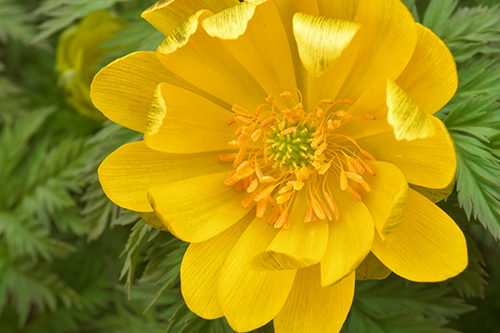
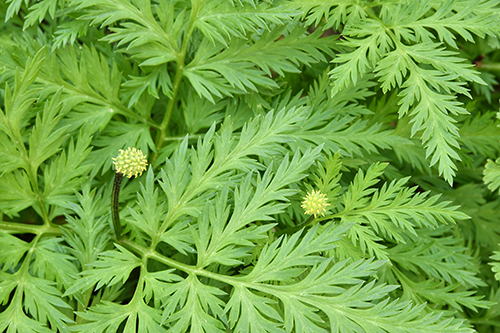
Arguably, there will always be a plant – actually, many plants – that we will never have the opportunity to learn, grow and enjoy in our gardens. Spring ephemerals are especially difficult to find and add to our gardens with their rather limited period of flower and foliar interest. Still, these plants are most certainly worth the effort to locate. Adonis amurensis adds a great touch of color while snow is retreating, yet long before most spring bloomers have yet to awaken. Its obvious indifference to late winter's chill, affiliation with celestial personalities, and boldly attractive flowers makes Adonis no mere mortal of a winter bloomer!
